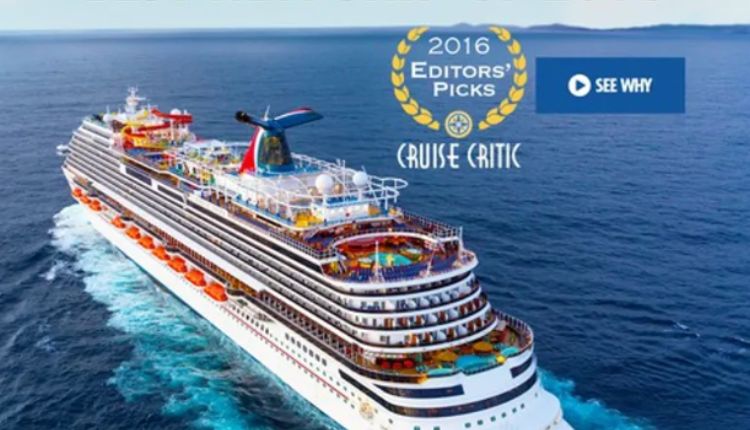Riding The Waves Of Profit: Unraveling The Resilience Of Carnival Cruise Stock
Introduction
In the ever-changing world of stock markets, investing in cruise industry stocks has been a subject of immense speculation and intrigue. Among the prominent players in the cruise industry, Carnival Corporation & plc stands as a giant, known for its iconic brand, Carnival Cruise Line, and a fleet of renowned cruise ships. However, the company’s journey hasn’t always been smooth sailing, especially with the unprecedented challenges posed by the COVID-19 pandemic. In this article, we will explore the resilience of Carnival Cruise stock, examining its history, weathering market storms, and strategies for navigating turbulent waters.
Section 1: A Voyage through History
To understand the present state of Carnival Cruise stock, it’s crucial to delve into its history. Founded in 1972 by Ted Arison, the company grew exponentially over the decades, expanding its fleet and global presence. The 2008 financial crisis tested the cruise industry’s resilience, but Carnival managed to stay afloat and eventually bounce back. By offering unique onboard experiences and international itineraries, the company built a loyal customer base, contributing to its stock’s popularity among investors.
Section 2: Stormy Seas – The Impact Of COVID-19
Despite the company’s history of overcoming adversities, no challenge could prepare it for the storm that was the COVID-19 pandemic. As the virus spread worldwide, the cruise industry was among the hardest hit, with Carnival suspending operations and facing unprecedented financial losses. The stock prices plummeted, causing uncertainty among investors, and raised concerns about the company’s future viability.
Section 3: Navigating Choppy Waters – Crisis Management And Recovery
Carnival Cruise’s management had to respond swiftly and strategically to navigate these turbulent times. Implementing cost-cutting measures, securing additional funding, and reevaluating its operational protocols were essential steps taken by the company. Furthermore, Carnival focused on enhancing health and safety measures, restoring customer confidence, and adapting its marketing strategies to cater to changing consumer behaviors.
Section 4: Government Support And Legal Challenges
During the pandemic, Carnival Cruise, like many other companies, sought government assistance to mitigate the financial impact. This led to debates over the ethics of providing aid to large corporations and raised concerns about long-term implications on stock performance. Additionally, Carnival faced legal challenges related to passenger safety and contract cancellations, further adding to the complexities surrounding the company’s future.
Section 5: The Road To Recovery – New Horizons
As vaccination rates increased and travel restrictions eased, Carnival Cruise started to resume its operations. The return of cruises offered glimmers of hope for investors, leading to a gradual recovery of the stock’s value. However, it was evident that the road to full recovery would be challenging, requiring innovative approaches and adaptability to a changing market landscape.
Section 6: Sustainable Strategies for Success
To ensure long-term success and resilience, Carnival Cruise implemented sustainable strategies. These included investments in cleaner and more fuel-efficient ships, diversification of cruise offerings, and a focus on enhancing the onboard customer experience. Additionally, the company explored potential partnerships and acquisitions to strengthen its market position and weather future storms.
Section 7: A Sea of Opportunities – Investor Sentiments
As Carnival Cruise stock began showing signs of recovery, investor sentiments fluctuated. Some viewed the stock as an attractive opportunity for long-term growth, considering the company’s dominant market share and brand recognition. Others remained cautious, concerned about lingering effects of the pandemic and potential future disruptions to the cruise industry.
Section 8: Competing in a Changing Landscape
The cruise industry’s landscape underwent significant changes during the pandemic, with new players entering the market and customer preferences shifting. Carnival Cruise faced intense competition from rival cruise lines and alternative vacation options like all-inclusive resorts and adventure tourism. Adapting to these changes became pivotal in maintaining its position as an industry leader.
Section 9: The Ripple Effect of Environmental Concerns
As awareness of climate change and environmental impact increased, so did the scrutiny on the cruise industry’s practices. Carnival Cruise, like other companies, faced pressure to adopt more sustainable and eco-friendly practices. Failure to do so could not only affect its reputation but also impact investor confidence and stock performance.
Section 10: Conclusion
In conclusion, Carnival Cruise stock’s journey has been a rollercoaster ride, marked by highs and lows, trials, and triumphs. The company’s history of resilience and adaptability provides a glimmer of hope for investors, but it also serves as a reminder of the unpredictability inherent in the cruise industry. As the world recovers from the pandemic, Carnival Cruise faces both challenges and opportunities. By implementing sustainable strategies, embracing technological advancements, and staying attuned to evolving customer preferences, the company can steer towards a brighter and more stable future.
FAQs:
- Is Carnival Cruise a good investment option post-pandemic?
Post-pandemic, Carnival Cruise’s stock has shown signs of recovery, making it an enticing option for some investors. However, potential investors should carefully assess the company’s financial health, operational strategies, and long-term growth prospects before making any investment decisions. Investing in the cruise industry remains inherently risky due to unforeseen market changes and external factors.
- How does Carnival Cruise plan to address environmental concerns?
Carnival Cruise has recognized the growing importance of environmental sustainability and has committed to addressing these concerns. The company is investing in research and development of cleaner and more fuel-efficient ships. Additionally, it is exploring renewable energy sources and adopting responsible waste management practices to reduce its environmental impact. As the industry faces increasing scrutiny from consumers and regulators, Carnival Cruise aims to become a leader in sustainable cruise tourism.
Conclusion
Carnival Cruise’s stock has been through rough waters during the COVID-19 pandemic, but it has demonstrated resilience and determination to navigate the challenges. As the world moves toward recovery, the company’s strategies for crisis management, environmental responsibility, and adapting to changing market dynamics will determine its long-term success. Potential investors must carefully weigh the risks and opportunities before boarding the Carnival Cruise stock journey. In the end, whether it rides the waves of profit or faces new challenges, Carnival Cruise’s story remains an essential chapter in the annals of the cruise industry.




